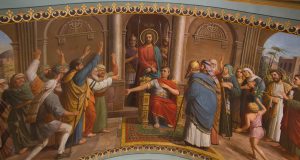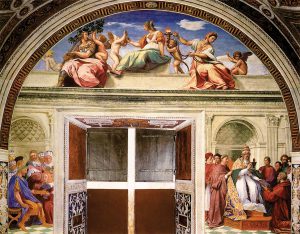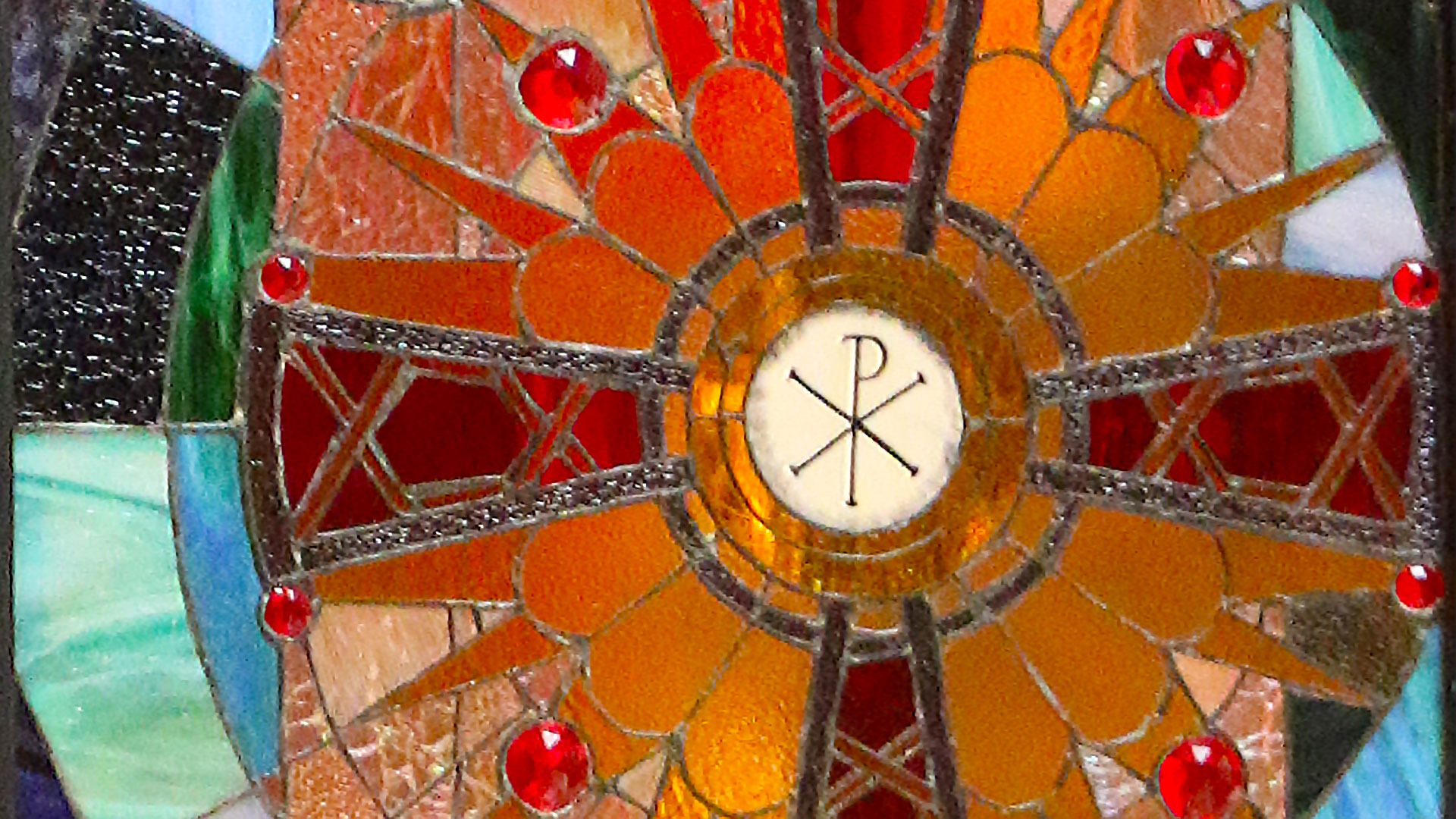
God created a world full of beauty—morning dew resting on the petals of a garden tea rose, a mother duck leading her flock of ducklings through a busy city to the river as cars stop to let them pass, a mother receiving her newborn on her chest moments after its birth.
As His most precious creation made in His image, God gave us the ability to create beauty as well. One way we do this is through various forms of art. The Catechism of the Catholic Church (CCC) describes these gifts this way:
“Created ‘in the image of God,’ man also expresses the truth of his relationship with God the Creator by the beauty of his artistic works. Indeed, art is a distinctively human form of expression; beyond the search for the necessities of life which is common to all living creatures, art is a freely given superabundance of the human being’s inner riches.” (CCC 2501)
Throughout the history of the Church, many of the faithful have created impressive works to help lift our minds and hearts upward to the Father, to heavenly things. We use these artistic expressions to tell the world about the truth God has revealed to us. We use them to raise our minds and hearts to higher realities.
“Like music, literature and architecture, art is a way in which Catholics have expressed their adoration of, and love for, God since the resurrection of Jesus Christ,” says Monsignor Charles Mangan, parochial vicar for St. Mary of Mercy, Alexandria, St. Stephen, Bridgewater, and St. Martin, Emery. “Art is a creative outlet that allows Catholics to rejoice tangibly in the goodness and the mercy that they have received from Our Lord. It is also a vehicle by which Catholics express their hope for eventual union with the Most Blessed Trinity in heaven, and their desire for the intercessory assistance of Our Lady and the angels and the saints.”
Perhaps the most amazing part of creating works of art is the way we participate with God in becoming a sort of co-creator when we use those artistic gifts. We offer the rest of the world another ray of light, another way of seeing beauty. And for our efforts, the Lord often blesses us in turn.
“When we adore God by way of art, we call upon His favor upon us,” Monsignor Mangan says. “And the very act of representing God and all things holy by way of art impresses upon us the beauty of the Lord and our serious responsibility to adore and love Him.”
Many talented artists live in our diocese, offering their God-given skill to reveal His glory more fully to us. Let’s meet a few.
Darwin Wolf
 Sculpting chose him, not the other way around. This was how Darwin Wolf, parishioner at St. Katharine Drexel in Sioux Falls, knew God had a hand in what has become his life’s passion and his full-time work.
Sculpting chose him, not the other way around. This was how Darwin Wolf, parishioner at St. Katharine Drexel in Sioux Falls, knew God had a hand in what has become his life’s passion and his full-time work.
His goal was to study painting at the University of South Dakota, but by chance he ended up at Northern State University (NSU). After taking a mandatory sculpting class at NSU, the only class of its kind in the entire state at the time, his painting ideas dried up and he started to see everything in 3D.
“I saw bronze poured for the first time,” Wolf said. “The heat, the noise and the unpredictability had me hooked. I still get an adrenaline rush every time I pour bronze.”
The Holy Spirit has been working in his life all along the way, bringing him back to his bronze sculpting career 15 years after he had left it, thinking it was dead. Chance meetings (including with his wife Dawn), random Bible study groups, multiple moves, and new jobs all led to Wolf getting his first two major commissions that restarted his career and saved him from an impending mid-life crisis. He now creates one-of-a-kind bronze sculptures full time. That crazy twisting road to his life’s work has God’s hands all over it.
“I’d have to be a complete fool not to believe,” he said.
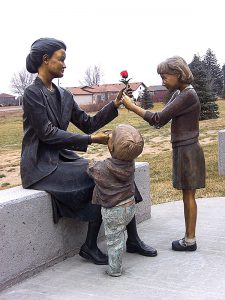 Wolf needs strong subjects to stay inspired because one life-size bronze can take up to 18 months to complete. To get himself through the long process, he typically sculpts human figures in historical, military and religious themes. Research in history and scripture helps to bring him inspiration and direction, and the sculpting process offers its own inspiration that reminds him again that the Holy Spirit is entering into his work.
Wolf needs strong subjects to stay inspired because one life-size bronze can take up to 18 months to complete. To get himself through the long process, he typically sculpts human figures in historical, military and religious themes. Research in history and scripture helps to bring him inspiration and direction, and the sculpting process offers its own inspiration that reminds him again that the Holy Spirit is entering into his work.
“When a certain detail seems perfect or the clay does something that’s unexpected but looks great, that’s known as ‘having the art talk to you,’” he says. “I call it the Holy Spirit doing his thing in my work.
“‘On the way’ is my life’s mantra. It comes from Luke 17:1-37. Jesus didn’t cure the ten lepers on the spot. They were told to go show themselves to the priests, and they were cured while ‘on the way.’ Taking action in faith makes things happen. I have to remind myself of this over and over when I hit creative blocks in my long sculpture processes.”
The greatest influence on Wolf’s work is Michelangelo, a strong Catholic and great artist. In his younger days, he intensely studied Michelangelo’s work in sacred art while at the same time skipping Mass and ignoring his own Catholic faith. He says the art he was so busy studying made it impossible for him to keep ignoring his own spiritual laziness. He gives it credit for bringing him back to his faith.
Wolf has also struggled with what he calls a “crisis of confidence” at various times throughout his career. He has days or even weeks when he doubts he can do the work and feels like a fraud. He has times when he avoids his studio completely. Many artists struggle with similar feelings. The secret to succeeding as an artist is to move past those feelings.
“When I refocus on my skill as a gift from God, I’m not as intimidated,” he says. “I can relax in the work and be inspired. It’s a whole different level of confidence when I know I’m not alone in making this career happen.”
 He has created some memorable bronze sculptures around the area: St. Therese with two children for St. Therese Parish (Sioux Falls), a pair of hands (one pierced by a nail and one with a rosary) for Avera Health (Sioux Falls), “St. Joseph and Students” for St. Joseph Indian School, “Msgr. Mac” at O’Gorman High School, crucifixes for Holy Name of Jesus (Watertown) and St. Lawrence (Milbank) Parishes, and “Fountain of Life” for the 125th anniversary celebration for the Diocese of Sioux Falls.
He has created some memorable bronze sculptures around the area: St. Therese with two children for St. Therese Parish (Sioux Falls), a pair of hands (one pierced by a nail and one with a rosary) for Avera Health (Sioux Falls), “St. Joseph and Students” for St. Joseph Indian School, “Msgr. Mac” at O’Gorman High School, crucifixes for Holy Name of Jesus (Watertown) and St. Lawrence (Milbank) Parishes, and “Fountain of Life” for the 125th anniversary celebration for the Diocese of Sioux Falls.
He’s received many accolades over the years and has learned to keep those in perspective.
“The belief in God-given gifts helps keep me humble,” Wolf says. “I sculpt in public a lot so I get plenty of feedback and compliments that can make me pretty full of myself if I’m not careful. I have to remember that God gives gifts to everyone, and many of those are far greater and more important than mine. Even though Michelangelo could ‘bring stone to life,’ he also had unshakable faith and humility. One of the phrases he used to keep egos in check was ‘Only God creates. The rest of us just copy.’”
To learn more about Darwin Wolf and his work, visit www.wolfbronze.com.
Molly Fulton
Artists often begin their love of art as children. Molly Fulton, parishioner at St. Agnes Parish in Vermillion, could often be found at the kitchen table as a kid creating something with any kind of drawing tool she could get her hands on. As she has moved through life, creating has given her a way to engage the world around her.
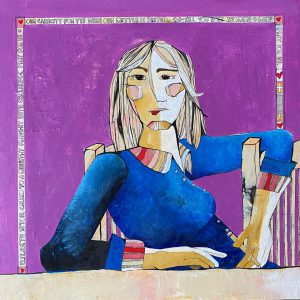 Fulton works mostly with acrylics on canvas and sometimes works with pen on paper. She says when she feels especially free she will mix the two. The two series of work she is currently focusing on fall into the acrylics category: one is an exploration of saint’s lives and the other of abstract landscapes.
Fulton works mostly with acrylics on canvas and sometimes works with pen on paper. She says when she feels especially free she will mix the two. The two series of work she is currently focusing on fall into the acrylics category: one is an exploration of saint’s lives and the other of abstract landscapes.
The first series, called Struggling Saints, is a study of people who strove to live holy lives. Fulton’s work is not your typical picture of a saint we’re all used to. She takes a modern angle and an unexpected twist on what we usually see in paintings of saints. The result is a fresh look at the saints of the Church.
The abstract landscapes series is drawn from her life as a South Dakota girl where landscapes have played a pivotal part in her world. She says the series is “a play on that feeling, that sense of flow, we get on the land.”
Fulton’s family provides a good deal of her inspiration because they “dive head first into life.”
“Creative work itself is messy, so it’s a pretty natural fit in many ways,” Fulton says of her family. “There’s no shortage of ideas to work with. Of course, that means I also find solace in quiet; being out hiking or more often running centers me. The earth is its own kind of inspiration.”
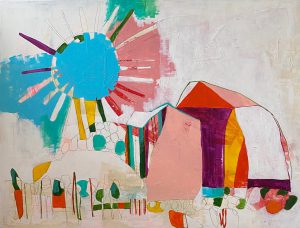 Creative work can help draw us out of ourselves according to Fulton. It helps us open up to others and for Fulton, it helps her open up to her faith.
Creative work can help draw us out of ourselves according to Fulton. It helps us open up to others and for Fulton, it helps her open up to her faith.
“Things I’m questioning or struggling with seem to come to light through my creative practice,” she says. “I may not recognize it as that, but I’m confident the Holy Spirit is working on me as much as I’m working. It makes it important that I stay active in my work. Staying present to my creative practice encourages me to stay open to wherever I might find Christ, find the Spirit at work in the world.”
Everything we have and are, including our creativity, is a gift from God. Fulton says she thinks when we don’t acknowledge our own creative impulses or gifts from God, we could be short-circuiting where the Spirit is trying to lead us.
As for creative ability, Fulton tries not to focus on it.
“I try not to be especially concerned with whether there’s artistic ability there or not. I think the real thing is to find the courage to do what you’re called to do. Show up, do the work, and let the Spirit provide the rest.”
To learn more about Molly Fulton and her work, visit www.mollynoemfulton.com.
Al Wentzell
Most people dream of finding true joy in their work. Al Wentzell, parishioner at Holy Name of Jesus Parish in Watertown, lives that dream every day working as an artist. He says he didn’t choose to be an artist. Instead it’s something he simply can’t live without. He has a powerful urge to paint, draw and build.
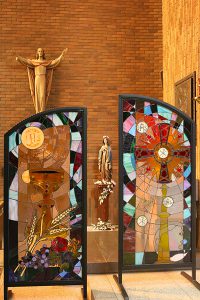 “God has given me this and I love it. It gives me hours of peaceful time to develop a piece of art,” Wentzell says. “It gives me patience to create designs that I hope will convey peace, love and belief in a beautiful world and take you away if only for a moment from day-to-day living.”
“God has given me this and I love it. It gives me hours of peaceful time to develop a piece of art,” Wentzell says. “It gives me patience to create designs that I hope will convey peace, love and belief in a beautiful world and take you away if only for a moment from day-to-day living.”
Growing up in Boston, Wentzell had access to any museum, church and cathedral he could get to on the MTA (public transportation in Boston at the time). These places offered great inspiration for him during his formative years. He drew and painted the things he saw on his trips in the city. His teachers noticed his talent and told him it was a gift from God.
“I always remember praying and asking God to make me an artist, and He answered my prayers,” he says. “I thank Him every day of my life.”
Today Wentzell paints and designs stained glass pieces that reflect a realistic representation of what he sees and feels. He and his wife taught stained glass to students at Mount Marty for seven years and they now own a gallery in Watertown.
“When I paint I want people to look at my work and feel as if they have been there or want to go there,” he says. “I want them to see what wonders God has given us and revel in the moment.”
Inspiration comes to Wentzell from books, windows in churches and cathedrals, and through prayer. His strong faith in God and the Church have helped him in his work and in his life.
“Whenever in life my family and I needed something, God has provided,” he says. “Not necessarily what I thought I wanted, but so is life. When I had to work in other areas to make a living, God gave me knowledge of that type of work, but he never stopped giving me my artistic ability.”
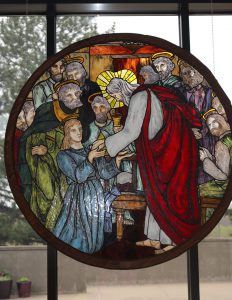 Wentzell recently created a pair of stained glass free-standing windows for Holy Name of Jesus Parish. The images of the precious chalice and the monstrance provide a bit of separation from the main church and the adoration chapel.
Wentzell recently created a pair of stained glass free-standing windows for Holy Name of Jesus Parish. The images of the precious chalice and the monstrance provide a bit of separation from the main church and the adoration chapel.
“I know that my talent is a definite gift of God. He is the reason I see what I see in the world. He is present in anything I do, but especially present in my mind as an artist. Whatever I do—paint, design and make stained glass, draw and teach—what I do is a result of the gifts He gave me.”
You can find Al Wentzell’s work at his studio/gallery, Birchtree Gallery & Framing and Northern Lights Stained Glass Studio, in Watertown or online at www.watertownartglass.com.
Paula Habbena
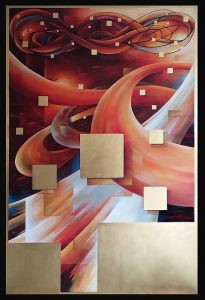 Paula Habbena of Sioux Falls says she felt most natural the day she picked up a pencil around age 2. She has been an artist most of her life because it drives and defines who she is as a person, but her spirituality has also played an equally important role. For her, her work often reflects how art and spirituality have “traveled hand-in-hand” and also how she has struggled to unify the two things most critical in her life.
Paula Habbena of Sioux Falls says she felt most natural the day she picked up a pencil around age 2. She has been an artist most of her life because it drives and defines who she is as a person, but her spirituality has also played an equally important role. For her, her work often reflects how art and spirituality have “traveled hand-in-hand” and also how she has struggled to unify the two things most critical in her life.
“I have always held within me this tremendous feeling of beauty. It has been a driving force, always giving meaning to my world and not just in the act of creating art,” Habbena says. “It’s like a song where I hear all these individual instruments, each playing a unique, breathtaking and complete melody which then combine into a most glorious piece, while, at the same time, the individual songs continue to play. I hear it when I create.”
She says she has come to understand her inspiration comes “from the level where everything and everyone is one, despite all the circumstances and divisions in life.”
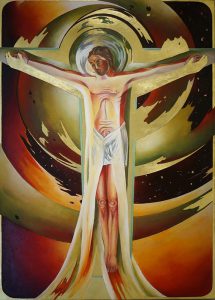 This kind of understanding comes from experience and a life lived intentionally. Habbena’s spiritual life blossomed during her 17 years living in a Benedictine community. There she gained a strong foundation in scripture, theology and liturgy, and how to live an authentic Christian life.
This kind of understanding comes from experience and a life lived intentionally. Habbena’s spiritual life blossomed during her 17 years living in a Benedictine community. There she gained a strong foundation in scripture, theology and liturgy, and how to live an authentic Christian life.
The Benedictine community also gave her the opportunity to learn art from legends in the art world. She now uses a variety of mediums when she works and focuses primarily on spiritual art. She’s found that the Catholic tradition provides an ideal setting for her creativity to really thrive.
“My Christian faith is my life. I must strive to live what I create or I might as well give it all up,” Habbena says. “The two are intrinsically bound. However, today my faith is more important than my art, something I couldn’t have always said. I no longer create art for art’s sake but only when I am called.”
She spends much time in prayer in order to prepare to create something new. One of her most challenging and moving projects was a series of what you might call “non-traditional icons” on the Trinity.
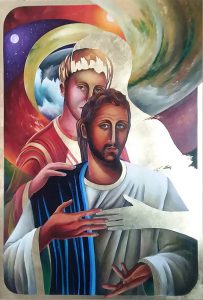 “The process requires much more from me than creating a typical painting or drawing. The practice is truly contemplative,” Habbena says. “I am asked constantly to surrender so I can be led. I spent five months in prayer and silence before actual production.”
“The process requires much more from me than creating a typical painting or drawing. The practice is truly contemplative,” Habbena says. “I am asked constantly to surrender so I can be led. I spent five months in prayer and silence before actual production.”
It’s an impressive series that can be contemplated for long periods of time and never fully grasped. It is evidence of the working of the Holy Spirit.
“My artistic ability is a gift from God, given for one purpose: To teach me how to grow into the gift so I can deliver back, giving glory in its return and completion (Trinity).”

